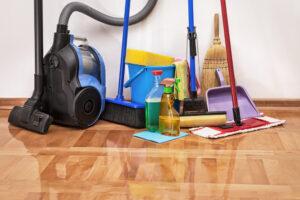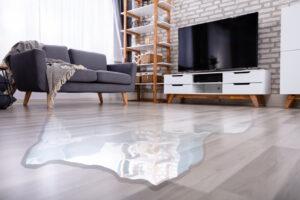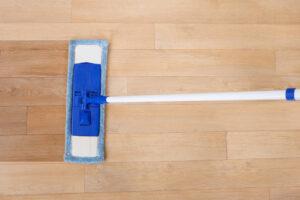How To Clean Hardwood & Engineered Hardwood Floors
Cleaning your hardwood and engineered hardwood floors couldn’t be more simple. Step one, sweep or vacuum off the dust. Step two, go over the floor with a slightly damp mop. That’s it, you’re all done. The problem is there are infinite opinions and products out there that have been around for many years, and it’s difficult to tell which one is the best for your brand-new hardwood flooring.
So let’s shed some light on the subject. We’ll go over vacuum cleaners, the steam mop, Castile soap, water damage, and the wear and tear of normal daily living.

The Old Days of Stripping Old Floor Wax
Many years ago, before today’s extremely tough protective coatings, hardwood floors were finished with boiled linseed oil, tung oil, orange shellac, wax, and all sorts of concoctions meant to protect the hardwood from water damage and scratches. Some were better than others, but in general, most had to be reapplied frequently.
I can remember my mom on her hands and knees, stripping off the old floor wax with turpentine and then reapplying the floor wax by hand. Then she would use this magical machine with two counter-rotating brushes to polish and then buff the floor to a shiny finish. Can you imagine doing that today? Unfortunately, you can’t even buy turpentine anymore in most states.
Water Damage From a Leak Is The Worst
Some types of water damage are easy to notice. For example, if you’ve ever had a broken waterline flood your hardwood flooring, you can end up with a floor with the kind of humps and bumps seen at a skatepark.
It’s hard to believe water can do this much damage. You can try to mop it up, but it’s too late once the water seeps into the solid hardwood planks. You’ll wake up the next day and see the planks warped and twisted like a tangled mess of Hot Wheels tracks.

Wear and Tear Water Damage
The water damage from the gradual wearing down of the protective finish on a hardwood floor is more difficult to see. Slowly but surely, abrasive grit will scratch away the protective coating, making it easy for water and moisture to discolor the worn area. If your type of flooring can be sanded down and refinished, then you’re in luck.
This is possible with most solid hardwood flooring. Engineered flooring is made with a very thin top layer of hardwood that might be able to be refinished. Distressed or hand-scraped flooring most likely cannot be sanded down and refinished.
Vacuum Cleaners Are Great For Hardwood Flooring
Most people don’t think of using a vacuum cleaner on hardwood flooring. That’s unfortunate because it’s one of the best ways to get rid of the tiny particles of abrasive dirt and dust that can wear down the finish.
Sweeping with a real horsehair broom is good. So is a broom with very fine synthetic bristles, if you can find one. Most brooms are great at picking up loose dirt but skip over the tiny grit that does the damage. A good vacuum cleaner with a smooth floor setting usually does the job.
Damp Mop Versus Steam Mop
Please don’t use a steam mop on your beautiful hardwood flooring. Most mops, called steam mops, don’t produce much steam, but if you find one that does, you could damage the finish on your floor.
Steam is an excellent way to clean off caked-on grease and grime, but it’s too harsh for many hardwood floor finishes. Yes, it will clean out the tiny crevices, but if it gets under the protective coating even just a little bit, it can spell big trouble. A damp mop head or a damp microfiber cloth is all you need.

Area Rugs To Protect Your Hardwood Flooring
It may seem obvious, but area rugs are often overlooked. An area with a non-staining grip mat under it can be placed at the most used entrance to help keep the dust and dirt off your floors.
Be sure to ask your floor expert which area rugs suit your hardwood floor. Some people end up with ugly stains caused by the wrong underpad. Some chemicals used in the area rug backing or underpad interact with those used in hardwood flooring’s protective coating. You can always return the wrong area rug, but who’s going to pay for the repairs to the floor?
Castile Soap, Murphy Oil Soap, Dish Soap, and White Vinegar
Cleaning tips often mention these when it comes to hardwood floors. If significantly diluted with water on a slightly damp mop or in a spray bottle, they can help remove stains. However, most will leave a residue that should be cleaned with a water-damped mop. In the end, you’ll be doing twice the amount of work, and most likely, a damp mop would have been enough in the first place.
Remember, what most people consider a stain isn’t a stain because it’s just sitting on top of the floor’s protective coating. If something is strong enough to get through the protective coating, then these products aren’t going to do much good anyway.
High Tech Protective Coatings
Whether you choose engineered hardwood or solid hardwood planks pre-finished or finished on-site, the coatings used to protect them are scientifically formulated to withstand day-to-day spills and traffic. If you can opt for the best available. It will be worth it in the long run.
How to Choose Your Flooring and Then How to Clean It
Engineered and solid hardwood flooring is an excellent addition to your home that can last very long. Find a local flooring expert you can trust. They can help guide you to the various type of flooring available and how to care for them once installed.
Do your research. Learn about the different kinds of flooring and the protective coatings used. Visit the retailers in your area if you have the time. If you don’t, schedule an appointment for a convenient, shop-at-home service.
(214) 390-0850


